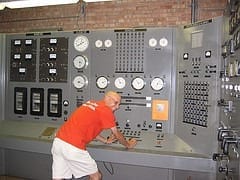Five questions about Argonne’s Endurance Bioenergy Reactor
What is the Endurance Bioenergy Reactor?
The Endurance Bioenergy Reactor (EBR) is a simple, easy-to-use portable system that uses bacteria to produce fuel that can go directly into engines and generators. By eliminating the need for refining, users can produce fuel onsite without complicated logistics. It can use waste streams or processed cellulosic materials as inputs to produce 25 to 50 gallons of biofuel a day, right where it’s needed. This boosts the operator’s self-sufficiency because it reduces dependence on supply chains and electrical or fuel distributors.
How does it work?
The bacteria within the EBR efficiently convert waste from kitchens or latrines into long-chain alcohols. Once separated from the fermentation broth, these serve as surrogates for diesel fuel that can be used alone or in blends to power vehicles or generators. One EBR can fuel a generator that can charge up to 60 light- to medium-duty electric vehicles per day. Each of these vehicles would have an estimated range of 50 miles.
Where can it be used?
Beyond obvious tactical advantages in military settings, the EBR can also support local infrastructure for native people as well as humanitarian activities around the world, producing fuel on location.
Because of the system’s simplicity, mobility and the fact that there are no differences between military and civilian versions, it can be applied easily in any type of setting.
What’s the science behind the conversion of waste to energy?
At the heart of the EBR is an engineered photosynthetic bacterium. This rapidly dividing organism uses plant enzymes and combines them with efficient light-harvesting machinery that is already normally abundant within these cells. These hybrid plant-bacterial reactions manufacture fuel molecules that are foreign to the bacterium, which then expels them into a culture medium where they can be sequestered, separated and used—without refining—in engines that normally run on diesel fuel.
What would it take to deploy EBRs in the field?
In some respects, we are at the tip of the iceberg in the development of EBR technology. We’re excited to see what the future brings, as we envision quite a few applications for the integrated system.
via Argonne National Laboratory
The Latest Streaming News: Bioenergy Reactor updated minute-by-minute
Bookmark this page and come back often
Latest NEWS
Latest VIDEO








